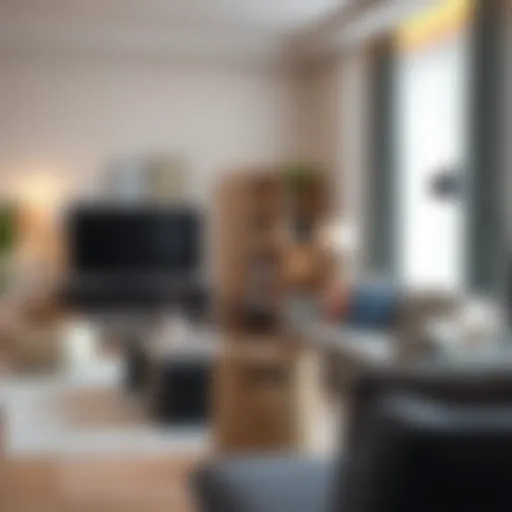Exploring Wooden Adhesive Hooks for Modern Homes
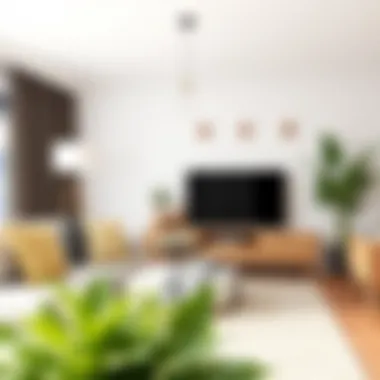

Intro
The increasing popularity of wooden adhesive hooks in home décor reflects a shift towards blending aesthetics with functionality. These simple yet effective tools offer more than just a means to hang items. They become part of the narrative that your living space tells about you and your lifestyle. This article will explore the practical uses and appeal of these hooks, illustrating their adaptability in various design trends while also addressing concerns of sustainability that resonate with modern homeowners.
As we move through the dynamic world of interior design, it’s easy to overlook small items like hooks that can make a daunting difference in organizing and beautifying spaces. Just think about the last time you visited a friend's house to find their hats or keys elegantly displayed rather than tossed haphazardly on a table. Those hooks, perhaps wooden, added a personal touch and functionality, making a case for their relevance in today’s homes.
In this piece, look for a thorough evaluation of how wooden adhesive hooks can enhance both utility and aesthetic appeal. We’ll discuss furniture design trends, delve into key buying guides for these hooks, and ultimately spotlight their synergy with both contemporary and traditional styles.
Prelims to Wooden Adhesive Hooks
In an era where innovative home solutions are indispensable, wooden adhesive hooks emerge as a fixture in the design landscape of contemporary living. They are not just functional items but also striking elements that embody a blend of practicality and aesthetics. Homeowners increasingly appreciate how these hooks can transform a mundane space into an organized and stylish haven. The significance of understanding wooden adhesive hooks extends beyond mere decoration; it covers aspects such as material properties, adhesive technology, and potential applications.
The appeal of wooden adhesive hooks lies in their versatile nature. They come in various finishes and styles, adapting to diverse interior themes, from rustic charm to modern minimalism. Homeowners and designers are drawn to how these hooks can contribute to enhancing the overall decor while serving critical functions. The exploration of wooden adhesive hooks reveals their benefits, one of which is the tendency to keep walls intact, handy for those who swear by rental properties governed by strict regulations against wall damage.
Consideration needs to be given to load capacity, adhesive durability, and the intended use within different environments of a home, such as kitchens or entryways. By understanding their application, individuals can maximize these hooks’ utility and aesthetic potential.
Defining Wooden Adhesive Hooks
Wooden adhesive hooks are designed to stick to a variety of surfaces—like painted walls, tiles, and wood—using a form of strong adhesive. Unlike their metal or plastic counterparts, they carry a unique organic appeal. Their production often involves sourcing sustainable wood types, adding an ecological angle to their use.
Integrating wooden adhesive hooks into daily life means more than just a way to hang items. It embodies an approach to living that values both form and function. For instance, a kitchen adorned with bamboo hooks can not only support aprons and utensils but also contribute to a greener lifestyle.
Historical Context and Evolution
The use of hooks dates back centuries, evolving from simple forged models to sophisticated designs that utilize modern adhesives. Historically, the transition from metal to wood in the home accessory sector reflects broader cultural shifts, including a heightened focus on sustainability and natural materials. Wood, as a resource, has been utilized since the dawn of civilization due to its abundance and versatility.
In recent decades, the advent of adhesive technologies has revolutionized how hooks function, eliminating the need for permanent fixtures that can damage walls. Early iterations of adhesive hooks were often less durable, leading to issues with adhesion and weight capacity; however, advancements in adhesive chemistry have paved the way for products that hold strong even in challenging environments.
As society continues to call for more sustainable and repurposed materials, wooden adhesive hooks find relevance in not just functionality but as pieces that tell a story of evolution, craftsmanship, and responsibility. This history is essential to understand where these products are today and anticipate how they will continue to play a vital role in modern living.
Material Properties of Wood in Hooks
When it comes to selecting wooden adhesive hooks, understanding the material properties of wood is essential. The right choice of wood can greatly influence both the functionality and aesthetics of these hooks, making them not only practical but also an appealing addition to modern living spaces. Certain woods have unique features that affect their durability, appearance, and usability in various environments.
Common Types of Wood Used
Pine
Pine is often favored for its affordability and lightweight qualities. This softwood is relatively easy to work with, making it ideal for crafting hooks that require precision. Its versatility shines through in its ability to accept paints and stains well, allowing homeowners to customize the look to fit their décor. One of the key characteristics of Pine is its natural resistance to warping, which is beneficial in environments where humidity may fluctuate. However, it may not hold heavy objects as well as some hardwoods, so it’s best suited for lighter items.
"Pine offers a balance of practicality and aesthetic flexibility, making it a solid choice for many applications."
Oak
Oak, known for its strength and rigidity, presents a stark contrast to Pine. It is a hardwood that boasts incredible durability, making it capable of holding heavier items without bending or breaking. Its beautiful grain patterns contribute a touch of elegance, making it a popular choice among homeowners looking to enhance their living space. One outstanding feature of Oak is its remarkable resistance to moisture and decay, suitable for areas like kitchens or bathrooms where humidity is common. The downside, however, is that it can be quite expensive compared to other types of wood.
Bamboo
Bamboo has gained popularity recently for its sustainability and unique aesthetic. Ethically sourced, it is actually a grass rather than traditional wood, making it an eco-friendly option. Its rapid growth and renewability set it apart in an era where sustainability matters. Bamboo is remarkably strong for its weight, and its flexibility makes it less likely to splinter, enhancing safety in home environments. However, one must note that it may require additional care to maintain its appearance over time.
Durability and Load-Bearing Capacity
The durability and load-bearing capacity of the chosen wood type play a crucial role in determining how effectively a hook can function in various settings. Factors such as the wood's inherent strength, treatment against moisture, and maintenance needs dictate how long these hooks will last and how many items they can hold securely. Incorporating suitable woods that combine strength with lightweight properties can lead to a more appealing and practical hook design, tailored to meet the diverse needs of homeowners and designers alike.
Adhesive Technology in Wooden Hooks
In the realm of wooden adhesive hooks, the adhesive technology plays a crucial role in determining their usability and effectiveness. The glue used can very much dictate how well a hook will hold over time, its impact on the surfaces it adheres to, and how user-friendly it is. Understanding these nuances can help homeowners and designers make informed choices that suit their specific needs. Different types of adhesives serve varying purposes, whether for longevity or repositioning, making it a fundamental aspect to consider.
Types of Adhesives Used
Permanent Adhesives
Permanent adhesives are designed for a long-lasting hold. Their standout quality is strength, ensuring that once a hook is affixed, it isn't going anywhere. This is particularly beneficial for those who seek reliability, like hanging bags or coats. Usually, these adhesives bind through a chemical process, creating a bond that withstands the test of time and conditions like humidity.
One unique feature of permanent adhesives is their resistance to temperature changes. For instance, a hook in a steamy bathroom won't easily peel off compared to adhesive types that are less durable. However, it's also worth noting that removing these hooks can be a hassle and might damage the underlying surface, which is a significant consideration for renters or those often changing their decor.
Removable Adhesives
On the flip side, removable adhesives boast flexibility. Suitable for renters or individuals who love switching things up, these adhesives are crafted to allow for easy removal without causing damage to the wall or surface when it's time to redecorate. A primary characteristic that makes them a popular option is their ability to hold items securely while being easily removable at the same time.
The unique feature of these adhesives is their micro-suction technology that clings tightly but is responsive to pull, preventing surface damage. They do have their limitations, however; while convenient, they may not support heavy items like a coat rack might require. Understanding this balance can help homeowners decide which adhesive fits their lifestyle.
Performance Metrics of Adhesive Bonds
Measuring how well adhesive bonds perform can include various factors:
- Load capacity: How much weight can the adhesive support before failing?
- Environmental resistance: How does the adhesive perform in different conditions such as humidity or temperature changes?
- Ease of removal: What is the potential for damage upon removal, and how easy is it truly to detach the hook?
These metrics provide valuable insight, guiding users in their choice based on their specific requirements and settings.
Overall, understanding adhesive technology in wooden hooks can greatly enhance practical decision-making when outfitting a home. Properly evaluating the types of adhesives and their respective performance metrics equips homeowners and designers to better navigate the array of options available.
Design Trends in Wooden Hooks
In today's fast-paced world, home decor is not merely about aesthetic appeal; it's also about finding solutions that balance beauty and practicality. Wooden adhesive hooks have risen in popularity due to their blend of functionality and design. This segment explores the latest design trends that enhance both the visual charm and usability of these simple yet effective home accessories.
Aesthetic Considerations
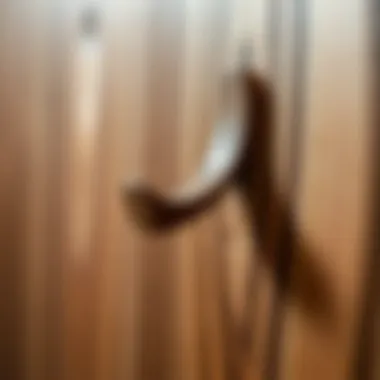

When discussing wooden adhesive hooks, the first thing that pops into mind is their aesthetic contribution to any space. The warm, organic look of wood can transform a plain wall into a warm inviting area. Unlike metal or plastic alternatives, wooden hooks add a touch of nature to indoor settings. They stand out without overpowering the rest of the decor.
Customers often gravitate towards smoother finishes and natural wood grains, which evoke a sense of comfort. Different wood species can provide a variety of textures and colors, allowing homeowners to match their hooks with existing furniture or add a striking contrast.
Some popular finishes include:
- Matte
- Glossy
- Stained
A key aspect of aesthetics is harmony. When hooks blend beautifully with other design elements, they elevate the overall decor. Thus, selecting hooks that either complement or artfully contrast with existing structures can significantly enhance a room's visual impact. Choosing from a range of styles, like modern or traditional, offers versatility in bringing personal tastes to life.
Functional Design Elements
Aside from looks, there are functional aspects to consider. All too often in design, practicality gets tossed out with the dishwater for the sake of style. But not here. Wooden adhesive hooks successfully combine utility with beauty, thanks to innovative design trends.
Minimalist Styles
Minimalist styles have taken the design world by storm. This approach cuts away the clutter and distills items down to their essence. Wooden hooks designed with minimalism in mind often feature simple lines and forms, offering a specific sophistication in any space.
A defining characteristic of minimalist hooks is their understated appearance. They serve their purpose without flaunting any excessive flair. This makes them a preferred choice for those leaning towards a streamlined decor. The beauty of minimalist design lies in its ability to seamlessly blend into various environments, making it a highly adaptable option for all homeowners.
However, while they may be visually appealing, some may find minimalist hooks lacking in the rustic charm of intricately designed products. Balancing minimalism with a hint of warmth can create a practical, inviting space without straying into the realm of cold and sterile.
Rustic Appeal
On the other side of the spectrum, rustic appeal has carved out its own identity. Characterized by a rugged charm and often incorporating reclaimed wood, rustic wooden hooks are perfect for those who crave connections to nature and Earthy vibes.
This type of design often showcases raw edges, knots, and imperfections, adding character and storytelling into the design. Many homeowners appreciate that these flaws tell a unique story, creating a more personal connection with the items they choose.
Yet, the rustic aesthetic isn't without its drawbacks. It can occasionally appear out of sync with sleek, modern decor styles. People who favor contemporary environments might find it challenging to integrate rustic appeal into their homes. However, when executed thoughtfully, rustic designs can impressively provide warmth and history while delighting the eye.
Designing with wooden hooks involves not just utility but also a dialogue between the styles and the spaces they inhabit.
In summary, the design trends surrounding wooden adhesive hooks offer various paths to enhance any living space. Whether you lean toward minimalist finesse or rustic charm, these hooks exist at the intersection of art and utility, aiding homeowners in achieving not just organization, but also a unique personal statement within their homes.
Practical Applications of Wooden Adhesive Hooks
Wooden adhesive hooks serve as a notable solution for various practical needs in modern living spaces. Their functionality extends beyond mere decoration; they are tools that merge utility with aesthetics. Homeowners, designers, and DIY enthusiasts often seek ways to enhance organization with style, and wooden adhesive hooks certainly rise to the occasion. Understanding the diverse applications of these hooks can lead to better living experiences.
Home Organization Solutions
In today's fast-paced world, maintaining organization is critical. Wooden adhesive hooks provide a fantastic means for keeping the home tidy without the need for drilling or permanent installations. These hooks can hold a variety of items – from kitchen utensils to coats in entryways. The natural wood finish adds an inviting and warm touch to any space, enhancing its charm.
Benefits of Using Wooden Hooks for Organization:
- Versatile Use: These hooks are suitable for various items, from keys to handbags.
- Quick Setup: They are easy to install and can be repositioned without leaving marks.
- Space Efficient: Ideal for small homes; they maximize wall space without cluttering surfaces.
When a homeowner considers utilizing wooden adhesive hooks, factors like load-bearing capability and the type of adhesive should be evaluated to ensure that they're matching the hook's use with its environment appropriately.
Creative Uses in Various Spaces
The beauty of wooden adhesive hooks lies in their flexibility and creative potential. Depending on where they are placed, their functionality evolves. They aren’t just plain hooks—they can be decorative elements that improve the aesthetic quality of your space while serving a purpose.
Kitchens
In kitchens, wooden hooks can be a game changer. They can serve as holders for utensils, dish towels, or even pots. A hook can replace the need for a bulky rack or drawer that takes up valuable counter space.
- Aesthetic Characteristic: The natural look of wood complements various kitchen styles, from farmhouse to modern.
- Benefits: Keeping essential cooking tools at arm's length encourages a smoother workflow. Unlike these clunky racks, hooks can add a neat, uncluttered feel to your cooking area.
Bathrooms
Bathrooms are often small, yet they can benefit greatly from the installation of wooden adhesive hooks. Think about using them for hanging towels, robes, or even decorative items like air fresheners.
- Key Feature: They can withstand humidity better than some materials, especially if cased in water-resistant finishes.
- Advantages: With their adhesive backing, a homeowner avoids drilling into tiles, which can be a hassle and may require extra care.
Entryways
Entryways can get crowded if not organized efficiently. Wooden adhesive hooks can be effectively utilized to hang jackets, umbrellas, and bags, creating a neater welcome space in the home. Save time on grabbing essential items while dashing out the door.
- Characteristic Aspect: They offer a stylish, minimal approach that contributes to a cleaner entry experience.
- Unique Feature: These hooks often highlight craftsmanship, giving a personal touch right from the moment you step in.
In summary, wooden adhesive hooks provide practical, stylish, and functional solutions for modern living, catering to both organizational demands and aesthetic preferences in various settings.
Sustainability in Wood Sourcing
Sustainability in sourcing materials has become a cornerstone in multiple industries, and the realm of wooden adhesive hooks is no exception. The increasing awareness of environmental issues necessitates a shift towards responsible practices that not only fulfill consumer demands but also ensure minimal ecological impact. In this context, wooden hooks represent an intersection of design and sustainability, merging aesthetic functionality with conscientious sourcing.
Choosing sustainable wood involves evaluating its origin, growth practices, and harvesting methods. Homeowners and designers alike are becoming more discerning, looking beyond simple function to the underlying principles that guide product development. By opting for materials that promote longevity and can be sourced ethically, consumers are directly contributing to a more sustainable future.
- Environmental Impact: Using wood derived from sustainable forests helps preserve biodiversity, combat deforestation, and maintain carbon neutrality. This wood is often harvested under strict management plans that ensure regeneration.
- Consumer Consciousness: The modern consumer is not just after aesthetics; they want to know the backstory of the product they are investing in. They seek assurances that their choices align with their values.
"Opting for sustainably sourced materials is not just a trend; it's a responsible lifestyle choice that reflects a commitment to the planet."
Integrating sustainability with design creates a compelling narrative for wooden adhesive hooks, presenting them as both a practical solution and a wise choice.
Eco-Friendly Materials
When discussing wooden adhesive hooks, eco-friendly materials take center stage. Options like bamboo or reclaimed wood highlight the potential for reducing environmental footprints.

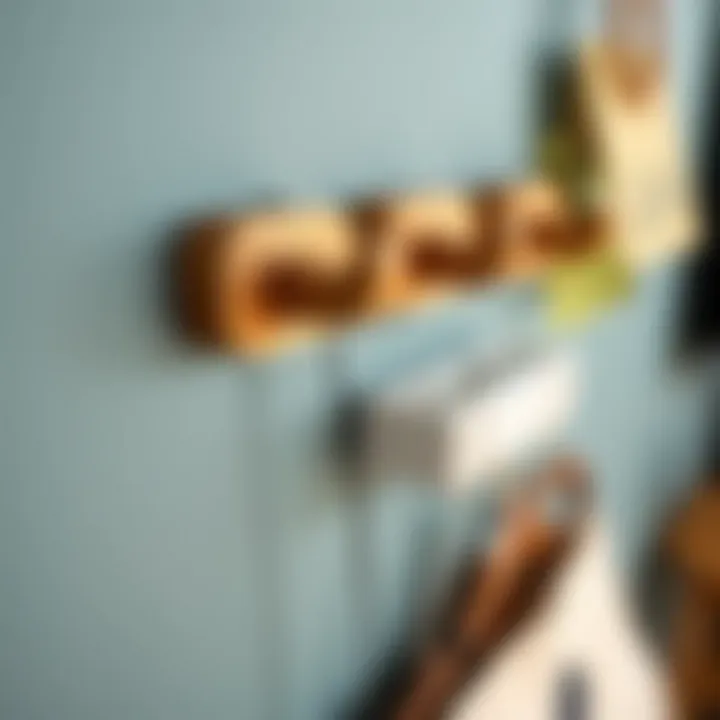
- Bamboo: This material is actually a grass and grows significantly faster than traditional hardwoods. Its rapid growth cycle means that it can be harvested sustainably without the risk of depletion. Not to mention, bamboo has natural antibacterial properties, making it a great candidate for various settings, including kitchens.
- Reclaimed Wood: This option breathes new life into old timber, preventing waste and reducing the demand for new raw materials. Using reclaimed wood not only diminishes the need for new logs but also tells a unique story through its previous existence.
- FSC-Certified Wood: Materials that receive certification from the Forest Stewardship Council ensure that they come from responsibly managed forests.
Incorporating these materials leads not only to innovative designs but also to a global effort to foster responsible consumption.
Impact of Sustainable Practices
The ramifications of sustainable practices in wood sourcing include significant long-term benefits that extend beyond individual purchasing decisions.
- Economic Empowerment: By supporting local sourcing, communities can bolster their economies. Sustainable forestry initiatives often empower indigenous communities, providing jobs and safeguarding cultural heritage.
- Reduction of Carbon Footprint: The production and transportation of hooks made from locally sourced, sustainable wood require less energy, subsequently lowering greenhouse gas emissions.
- Enhanced Product Quality: Sustainable practices emphasize quality over quantity. Products made from carefully sourced materials often have better durability and performance, reducing the need for replacement and promoting a culture of longevity.
- Awareness and Education: As the demand for sustainable products increases, it drives awareness among consumers and manufacturers about ecological issues. This, in turn, promotes innovation in sustainable practices across the board.
As a result, the impact of sustainable practices ripples through various sectors, merging ecological responsibility with attractive design features. This cohesive relationship ensures that the use of wooden adhesive hooks not only meets the immediate needs of today’s society but also preserves resources for generations to come.
Comparative Analysis with Other Hook Solutions
When looking at the realm of adhesive hooks, it’s imperative to explore how wooden adhesive hooks stack up against alternative hook materials. Understanding the differences not only helps in making an informed decision but also allows homeowners and designers to appreciate the distinct advantages offered by wood in both function and aesthetics.
Metal vs. Wooden Hooks
In the tug-of-war between metal and wooden hooks, both have their loyal adherents. Metal hooks often carry a sense of durability and modernity, making them quite popular in commercial settings. Yet, wooden hooks bring their unique flair to the table.
Benefits of Metal Hooks
- Strength and Load Capacity: Typically, metal hooks can bear heavier weights without bending or breaking.
- Weather Resistance: Metals like stainless steel are less likely to rust, making them suitable for outdoor spaces.
- Sleek Design: They tend to have a cleaner look, appealing to minimalist and modern sensibilities.
Advantages of Wooden Hooks
- Aesthetic Warmth: Wood adds a natural, inviting quality to spaces, complementing home décor beautifully.
- Sustainability: Sourced responsibly, wooden hooks can be eco-friendlier than their metal counterparts.
- Customization: They can easily be stained or painted to match any interior design, offering more adaptability.
When each type is considered, the choice often comes down to personal preference and specific needs for aesthetics versus strength.
Plastic Hooks: Pros and Cons
Plastic hooks often find their place in discussions about affordability and ease of use. However, a deeper look reveals a nuanced picture.
Pros of Plastic Hooks
- Cost-effective: Generally cheaper than both metal and wood options, which makes them accessible.
- Lightweight: They are easy to handle and install, making them a go-to choice for temporary solutions.
- Variety: Available in myriad colors and designs, they can adapt to various themes easily.
Cons of Plastic Hooks
- Durability Issues: Often, plastic can warp or degrade over time, particularly under heavy loads or heat.
- Aesthetic Appeal: They may lack the natural elegance that wooden hooks bring to a space, sometimes giving off a cheap vibe.
- Environmental Impact: Not all plastics are created equal; many aren’t recyclable and can contribute to waste.
Ultimately, the consideration of quality, sustainability, and design should weigh heavily in making decisions about which type of hook best suits the desired application.
In the world of home organization, the hook you choose can make all the difference in both functionality and style. Understanding these comparative aspects allows you to choose wisely.
For further reading, examining additional resources like Wikipedia and discussions on Reddit can provide community insights and experiences from other homeowners facing similar choices.
Installation Considerations
When it comes to wooden adhesive hooks, understanding installation considerations is crucial for optimizing their functionality and ensuring longevity. A hook that isn’t properly installed can lead to frustration, from items falling unexpectedly to potential damage to surfaces. This section focuses on key elements to assess before diving into installation, guiding you through achieving a seamless experience with these versatile tools.
Surface Compatibility
Choosing the right surface for your wooden adhesive hooks is one of the most important steps in the installation process. Not all surfaces are created equal, and ensuring compatibility can mean the difference between a reliable hook and a regrettable mishap.
Types of Surfaces Suitable for Installation
- Smooth Surfaces: Walls that are clean and free of texture—like painted drywall, glass, or tile—are usually ideal. The flatter the surface, the better the adhesive can grip.
- Non-Porous Materials: Wood finishes and laminated surfaces often provide good adhesion. These materials don’t absorb moisture, making it more likely that the adhesive will hold strong.
- Avoiding Problematic Areas: It’s wise to steer clear of surfaces painted with high-gloss finishes, as they can prevent proper adhesion. Similarly, any areas that see high humidity or repeated contact, like bathroom walls or behind sinks, may not suit a reliable installation.
“Proper surface selection can make or break your experience with wooden adhesive hooks.”
Ensuring that the surface is clean and dry before application is also essential. Dust, grease, or water can interfere with how well the adhesive sticks, leading to an unpleasant surprise when items come crashing down.
Step-by-Step Installation Guide
Installing wooden adhesive hooks is usually a straightforward process, but following specific steps can take the guesswork out of it. Here’s a simple guide to help you get it just right:
- Choose Your Hook and Location
Select how you want to use the hook—whether for keys in the entryway, utensils in the kitchen, or towels in the bathroom. Visualize where it fits best. - Prepare the Surface
Clean the area thoroughly with a mild cleaner. Ensure it's completely dry before proceeding. This step cannot be skipped for optimal results. - Mark Your Position
Using a pencil, lightly mark where the hook will go. This is especially helpful if you're aligning it with other hooks or items, ensuring a cohesive look. - Remove the Backing
Carefully peel off the adhesive backing from the hook. Make sure not to touch the adhesive part to prevent oils from your fingers affecting adhesion. - Press Firmly
Align the hook with your mark and press it onto the surface. Applying steady pressure for about 30 seconds enhances the bond, ensuring that it sticks well. - Follow Drying Guidelines
Some companies have specific drying times before adding any weight to the hooks. Make sure to adhere to those recommendations to avoid disappointment. - Test Its Strength
After allowing sufficient time for adhesion, gently test the hook with lighter items to see how well it holds. Gradually add weight to ensure it can carry what you intend to hang.
By following these steps, you'll likely find that installing wooden adhesive hooks is not only easy but can also enhance the organization and aesthetics of your living spaces. Taking time to consider these details pays off in the long run.
Maintenance and Care of Wooden Hooks
When we think about wooden adhesive hooks, the focus often goes straight to their aesthetic appeal and functionality. But just as with any home accessory, proper maintenance is crucial. Ensuring that these hooks remain in good condition doesn't only extend their life; it also maintains their visual charm and functionality. Grime and dust can accumulate over time, possibly affecting how well they adhere to surfaces or how they look in your living space.
Taking care of wooden hooks goes beyond just cleaning; it involves an understanding of their materials and design. Proper care can prevent deterioration, ensure reliability in hanging items, and keep the space looking sharp and tidy.
Cleaning Methods
Cleaning wooden adhesive hooks can be a simple task, yet it’s vital for performance and looks. Here are some effective methods to consider:
- Gentle Wipe Down: Use a soft, dry cloth to wipe the surface regularly. This prevents dust build-up and keeps them appealing. Avoid abrasive materials to prevent scratches.
- Mild Soapy Solution: For deeper cleaning, mix a small amount of mild dish soap with water. Dampen a cloth with the solution and gently wipe the hooks. Ensure that you don’t saturate them, as excess water can weaken the adhesive.
- Microfiber Cloth Use: A microfiber cloth can be your best friend when it comes to dust removal. It's effective at picking up dirt without scratching the wood.
- Avoid Harsh Cleaners: Chemicals in strong cleaning agents can be detrimental to the finish of the wood and adhesive properties. Stick to natural cleaning solutions whenever possible.
Keeping hooks in peak condition through regular maintenance helps them perform well and last longer.
Longevity and Performance Retention
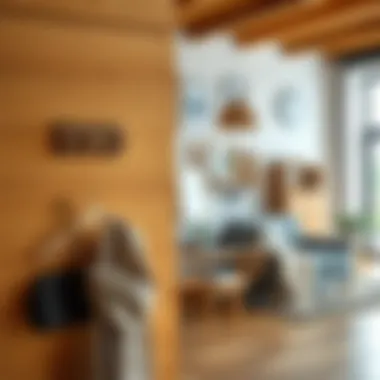
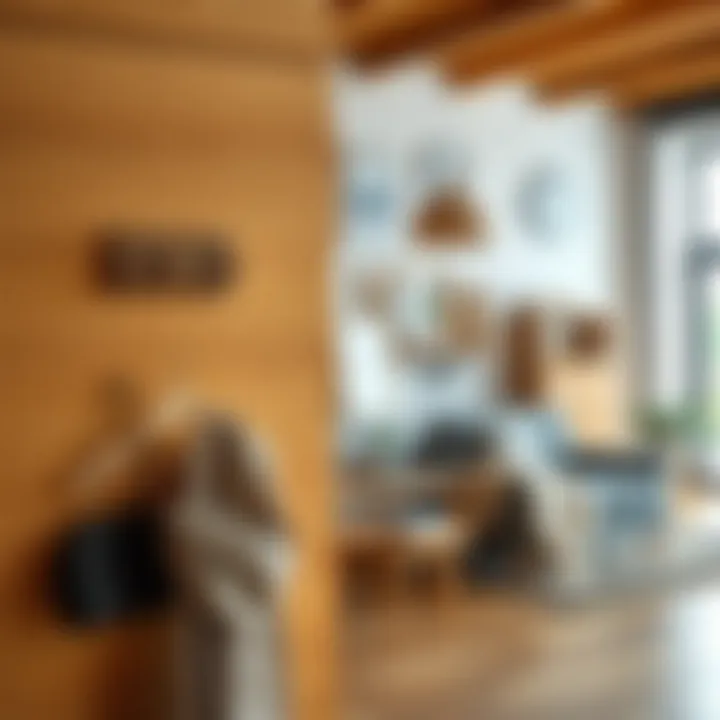
The lifespan of wooden adhesive hooks heavily relies on how they’re cared for. Performance retention—which refers to how well the hook holds up under weight and stress—depends not only on their installation but also on continuous maintenance.
Factors to Consider for Longevity:
- Environmental Conditions: Hooks in humid or extreme temperature conditions are susceptible to warping or losing adhesion. Try to use them within recommended temperature ranges.
- Weight Limits: Adhering to the manufacturer’s recommendations on weight limits will prolong the hook's effectiveness. Overloading can not only damage the hook but lead to accidents.
- Routine Checks: Incorporating a quick check-up on the adhesive bond ensures that it hasn’t loosened or created gaps. If signs of wear are evident, addressing them early can prevent larger issues.
- Sealing for Protection: Applying a wood sealant can protect the hooks from moisture and staining, adding another layer to their longevity.
In summary, maintenance and proper care are non-negotiable for anyone looking to enjoy the aesthetic and practical benefits of wooden adhesive hooks. With these methods and considerations, you can ensure that your hooks remain functional and beautiful, adding value to your home for years to come.
User Experiences and Testimonials
In the realm of home improvement and organization, the significance of user experiences and testimonials cannot be overstated. They provide a window into real-life applications of wooden adhesive hooks, allowing prospective buyers to gauge the practicality and benefits from those who have used these products. By sharing anecdotes, insights, and evaluations, users contribute to a collective understanding that enhances decision-making.
The value of integrating user feedback in this article serves multiple purposes. First, it is a direct reflection of the product’s efficacy. Second, it showcases the versatility of wooden adhesive hooks, revealing how these seemingly simple items can meet diverse needs. Lastly, these experiences underscore the importance of considering the nuances, such as installation challenges or performance under specific conditions.
Throughout this section, readers will discover how wooden adhesive hooks not only complement aesthetics but also provide solutions to everyday challenges. Real-world accounts reinforce the concept that functionality and style can coexist, revealing how such hooks integrate into varied environments—be it a bustling family kitchen or a minimalist entryway.
Feedback from Homeowners
Homeowners typically express varied perspectives on their experience with wooden adhesive hooks, often sharing stories about how these hooks have improved their living spaces. For instance, many users find that they not only serve as a practical storage solution but also add an element of warmth and character to their walls.
- Convenience and Adjustability: Homeowners frequently emphasize the ease of installation; a mere peel-and-stick process tends to delight novices and seasoned decorators alike. The ability to reposition these hooks without damaging walls is another aspect that many cherish, allowing for seasonal rearranging or response to changing needs.
- Aesthetic Choices: The finish and design of wooden adhesive hooks earn high praises. Customers mention how they can find options that suit their decor, from sleek maple hooks to the rustic charm of reclaimed wood. As one customer noted in an online review, "I never knew a small hook could make such a big difference in my hallway's vibe!"
Case Studies on Effectiveness
Analyzing specific case studies reveals significant insights into the performance of wooden adhesive hooks in diverse settings. These studies often highlight practical applications that illustrate not only the utility but also the shortcomings under real conditions.
- Kitchens and Storage Solutions: In a busy kitchen, a case study demonstrated the successful use of wooden adhesive hooks for hanging cookware and utensils. Homeowners reported that these hooks could bear substantial weight when correctly adhered to smooth surfaces, leading to a clutter-free environment.
- Handling Climatic Changes: Another study focused on bathroom use, where humidity levels can fluctuate. Users shared their experiences regarding hook durability in moist conditions, noting that specific wood types, such as bamboo, performed exceptionally well without warping or losing adhesion.
This combination of feedback and case studies provides a broader understanding of how wooden adhesive hooks function in various settings. As such, prospective buyers are encouraged to consider user experiences as pivotal pieces of information when contemplating the purchase of these functional and stylistic accessories.
Cost Analysis of Wooden Hooks
When it comes to selecting home organization solutions, understanding the cost dynamics of wooden adhesive hooks holds a significant place. Homeowners and design professionals alike must navigate through price points and overall value to make informed choices that align with both budgetary constraints and stylistic preferences. By evaluating costs, individuals can identify not only what fits within their financial plan, but also what meets the functional and aesthetic standards of their living spaces.
As wooden adhesive hooks grow in popularity, differentiating between standard and premium options becomes key. An insightful cost analysis aids in determining how these hooks can impact overall home expenses.
Price Ranges and Variability
The initial glance at wooden adhesive hooks reveals a wide array of prices that can fluctuate based on factors like brand, wood type, and design intricacies. In the market, you might stumble upon simple hooks priced around $5 to $10, while more robust designs or artisan-crafted hooks can skyrocket upwards of $30. Here’s a closer look at how price variability can shape your purchasing decisions:
- Material Quality: Higher-quality woods such as oak or teak tend to command a higher price. Their durability and aesthetic appeal often justify the cost when considering long-term use.
- Design Complexity: Hooks that come with sophisticated or custom designs generally cost more. Curved shapes or intricate patterns require more craftsmanship, naturally pushing up the price.
- Brand Influence: Just like in any other product category, some brands have established themselves as premium players in the adhesive hook market, which can influence pricing significantly.
Understanding these nuances can lead to a more strategic selection process.
Value Assessment Against Alternatives
Delving into value involves more than mere numbers; it demands a comparison of wooden adhesive hooks against their counterparts, such as metal and plastic hooks. Evaluating their worth can shed light on whether they provide adequate bang for the buck. Consider these crucial aspects:
- Longevity: Wooden hooks often outlast their plastic equivalents, which can degrade or break easily, thus potentially saving money in the long run. While initially higher priced, investing in wooden options may yield better durability, meaning less frequent replacements.
- Aesthetic Appeal: Aside from functionality, wooden adhesive hooks bring a certain charm that can elevate home décor. Their organic warmth contrasts starkly with the coldness of metal or the blandness of plastic. If aesthetics play a role in your decision, wooden hooks present a compelling value proposition.
- Eco-Friendliness: Wooden hooks, especially those sourced sustainably, offer a greener alternative compared to plastic options that harm the environment. An investment in wooden hooks can symbolize a commitment to sustainability, which might just hold more value for conscious consumers.
"When weighing your options, consider not just the price tag but the long-term benefits wooden adhesive hooks bring to your home."
Future of Wooden Adhesive Hooks
The future of wooden adhesive hooks holds a significant place in the conversation of interior design and functionality. As we navigate through an evolving landscape of home décor, these simple yet effective tools emerge as both practical solutions and design statements. Their blend of aesthetics and utility appeals not only to homeowners looking to declutter but also to designers who value sustainability and innovation in their projects. By examining the trajectory of wooden adhesive hooks, we can understand their growing relevance in modern living spaces, revealing trends that are very likely to shape their future.
Innovative Designs on the Horizon
When considering the advancement of wooden adhesive hooks, one cannot overlook the exciting innovation at play. Designers are starting to experiment with unconventional shapes and finishes. Picture a hook resembling a flowing branch or a sleek geometric figure, each not only serving a functional purpose but also becoming a focal point in home décor. The incorporation of juxtaposed materials, like combining wood with metals or glass, creates a visually stunning piece that complements various styles from bohemian to contemporary.
Moreover, technology is paving new pathways. Imagine hooks equipped with smartphone apps that notify users if an item is over its weight capacity or hooks that can change color based on their surroundings. Such adaptations not only enhance functionality but also elevate the user experience. Consumers increasingly prioritize smart design, which seamlessly integrates into existing home environments while offering more versatility than ever before.
Yet, despite the emerging trends, there remains a timeless quality to the aesthetic of wood. Natural textures and finishes still ignite warmth in spaces, providing a sense of comfort and familiarity. This balance between innovation and tradition is essential for manufacturers aiming to cater to a wide range of preferences and requirements.
Predictions on Market Trends
Analyzing the trends in wooden adhesive hooks gives rise to several insightful predictions. As awareness of sustainability rises, consumers are more inclined toward products sourced from eco-friendly materials. This trend points to a surge in demand for sustainably harvested woods, allowing manufacturers to gain a competitive edge by adopting responsible practices. The use of bamboo, in particular, is expected to gain traction due to its rapid growth cycle and minimal environmental footprint.
Moreover, we can expect a shift in markets as global consumers become more informed. The rise of online shopping has democratized access to niche products; thus, brands focusing on wooden adhesive hooks can capitalize on platforms like Amazon or Etsy. These platforms allow artisans and smaller businesses to reach a larger audience, presenting options that might not be available in traditional retail stores.
Furthermore, the trend towards minimalism and multifunctional design will likely continue to grow. Consumers seek solutions that not only declutter but also offer design elegance. Wooden adhesive hooks that arrive in minimalist designs or that serve multiple purposes (like a hook that doubles as a shelf) will find favor.
Closure and Key Takeaways
In this article, we have ventured into the world of wooden adhesive hooks, shedding light on their multifaceted role in modern living. The discussion around these hooks stretches far beyond mere functionality; it encapsulates design aesthetics, sustainability, and practicality. The key takeaways can be summarized into several pivotal themes that homeowners, designers, and DIY enthusiasts will find increasingly relevant.
Summary of Findings
Wooden adhesive hooks represent a blend of utility and charm. Firstly, they provide an array of practical applications across various spaces in a home, from the kitchen to the bathroom. Unlike traditional hooks that often dominate the décor, wooden hooks lend a more natural, warm aesthetic that can complement any style of interior design. Furthermore, understanding the different wood types—like pine, oak, and bamboo—allows for a selection that aligns with specific functional needs and design preferences.
- Material Choice: The type of wood significantly influences durability and load-bearing capacity.
- Adhesive Technology: Different adhesives can be chosen based on whether a more permanent or removable fixture is desired, catering to various user needs.
- Sustainability: As the demand for eco-friendly home solutions grows, the sourcing of wood and the impact on advanced environmental practices is vital in choosing wooden hooks.
Moreover, modern design trends favor simpler, minimalist approaches while still showcasing rustic elements that resonate with contemporary homeowners. These aspects combined create a product that not only serves a functional purpose but also enhances a home's aesthetic appeal.
Final Thoughts on Implementation
Implementing wooden adhesive hooks in your home can be straightforward yet rewarding. Before you leap into the installation, consider the following factors:
- Surface Compatibility: Assess the area where you plan to install the hooks, ensuring that the surface can support the adhesive and the weight of items you’ll hang.
- Installation Process: A proper installation ensures that your hooks serve their purpose without the risk of premature detachment or damage.
Ultimately, as you think about integrating wooden adhesive hooks into your living spaces, remember that they are not only about hanging your items; they are about creating a specific ambiance, expressing personality through design, and doing so while being mindful of the environment. By leveraging the insights provided in this article, one can enhance the functionality and aesthetic quality of their living areas while embracing sustainable practices.
Exploring these wooden hooks also opens a window into future product innovations that promise to further blend utility with style, making them a lasting choice for modern homes.







